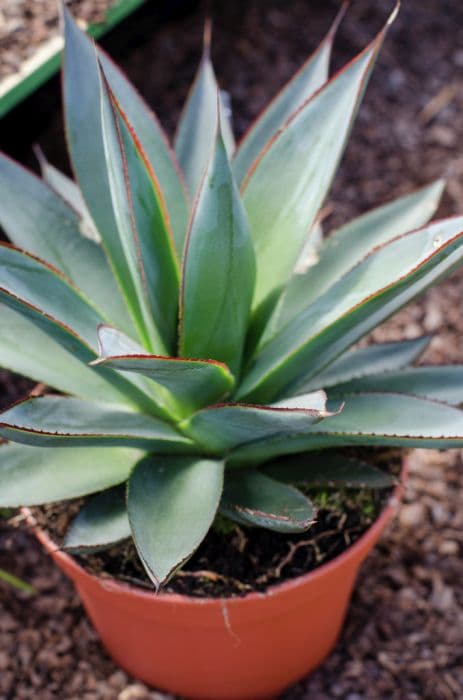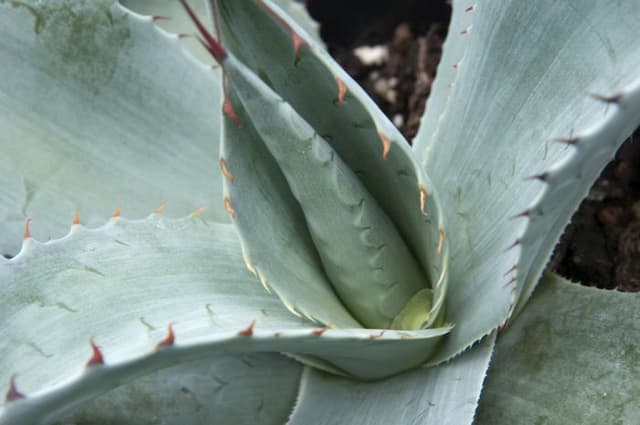Mountain agave Agave montana

ABOUT
A. montana is a rosette-forming, evergreen, perennial succulent to about 1.5m. The leaves are light greyish-green, edged and tipped with reddish spines. Plant have not been in cultivation long enough to assess flowering, but in the wild it produces huge, club-shaped inflorescences made up of tightly clustered yellow flowers on short branches supported by a scaly, 5m high trunk
About this plant
 Names
NamesFamily
Asparagaceae
Synonyms
Mountain Agave, Montana Agave
Common names
Agave montana.
 Characteristics
CharacteristicsLife cycle
Perennials
Foliage type
Evergreen
Color of leaves
Green
Flower color
Yellow
Height
3-4 feet (0.91-1.22 meters)
Spread
3-4 feet (0.91-1.22 meters)
Plant type
Succulent
Hardiness zones
7
Native area
Mexico
Benefits
 General Benefits
General Benefits- Landscape Enhancement: Agave montana adds architectural interest to gardens with its rosette of large, spiny leaves and a robust appearance.
- Drought Tolerance: This plant is highly adapted to arid environments, requiring minimal water once established, making it an excellent choice for water-efficient landscaping.
- Cold Resistance: Unlike many other agave species, Agave montana is relatively cold-tolerant, allowing it to be grown in areas with cooler temperatures.
- Low Maintenance: It requires very little upkeep in terms of fertilization, pruning, or pest control, making it ideal for low-maintenance gardens.
- Soil Erosion Control: With its extensive root system, it can help stabilize soil on slopes, reducing erosion.
- Pollinator Attraction: When it blooms, the tall flower spikes attract pollinators such as bees and hummingbirds, supporting local ecosystems.
- Long Life Span: Agave montana can live for several decades, providing a long-term presence in the landscape design.
- Uses in Xeriscaping: The plant is an excellent choice for xeriscaping, due to its adaptability to thrive in low-water conditions.
- Edible Parts: Although not focusing on medical or purifying attributes, the sap and heart of agaves are traditionally used to make sweeteners and alcoholic beverages.
 Medical Properties
Medical Properties- Antimicrobial: Agave montana has been used in traditional medicine for its potential antimicrobial properties, which could help to prevent or treat infections.
- Anti-inflammatory: Components within the plant may have anti-inflammatory effects that could be beneficial in treating conditions associated with inflammation.
- Antioxidant: The plant may contain antioxidant substances that can help in protecting the body from oxidative stress and related diseases.
- Wound healing: Agave montana sap or juices have been traditionally applied to wounds to promote healing, although scientific evidence to support this use may be lacking.
 Air-purifying Qualities
Air-purifying QualitiesThis plant is not specifically known for air purifying qualities.
 Other Uses
Other Uses- Agave montana fibers can be used for making ropes and twines, which are durable and resistant to degradation.
- The heart (piña) of the Agave montana can be roasted and eaten, offering a sweet and fibrous snack.
- Its pointed leaves have been utilized as needles or awls in traditional crafts and sewing by indigenous people.
- The sap of Agave montana can be used as a natural adhesive or glue in various crafting applications.
- Agave montana can be planted as a barrier plant because of its spiny edges and rosette formation, providing a natural fence against animals and intruders.
- Its leaves can be processed to make paper, traditionally used in some cultures for religious and ceremonial purposes.
- Used in landscaping, Agave montana can help with erosion control on slopes due to its extensive root system.
- When dried, the flower stalks of Agave montana can be used for building lightweight structures or as a sustainable material for making furniture.
- The dense flower clusters can be used as ornamental dried flowers for interior decoration and craft projects.
- In certain regions, Agave montana plants serve as habitat and food source for local wildlife, playing a role in preserving biodiversity.
Interesting Facts
 Feng Shui
Feng ShuiThe Agave is not used in Feng Shui practice.
 Zodiac Sign Compitability
Zodiac Sign CompitabilityThe Agave is not used in astrology practice.
 Plant Symbolism
Plant Symbolism- Resilience: Agave montana is known for its ability to survive in cold climates and rocky soils, symbolizing the ability to endure and overcome difficult conditions.
- Adaptability: This plant can adapt to various environments, representing flexibility and the capability to thrive in different situations.
- Longevity: Agaves live for many years and flower once at the end of their life cycle, symbolizing patience and the concept of a life well-lived leading to a final, remarkable achievement.
- Protection: With its strong, spiky leaves, the Mountain Agave can symbolize safeguarding and defense against threats.
- Purity: Often associated with its use in making tequila, it can represent cleansing and purification, as the distillation process purifies the liquid.
 Water
WaterThe Mountain Agave should be watered sparingly, as it is highly drought-tolerant. Typically, watering once every two to three weeks during the hot growth season is sufficient, providing about a gallon of water. During winter, reduce watering to once a month or even less if the plant is established. Check the top inch of soil for dryness as a guide; water only when it's completely dry. Overwatering can lead to root rot, so ensure good drainage.
 Light
LightMountain Agave thrives in full sun to partial shade. The ideal spot would be where it receives direct sunlight for at least 6 to 8 hours daily. If grown indoors, a south-facing window is the best location to ensure it gets enough light.
 Temperature
TemperatureMountain Agave is adapted to cooler mountain climates and can withstand temperatures as low as 10 degrees Fahrenheit but generally thrives in temperatures between 50 and 80 degrees Fahrenheit. Protect from extreme cold by providing some coverage or moving it indoor during the harshest winter months.
 Pruning
PruningPruning of Mountain Agave is mainly to remove any dead or damaged leaves and should be done carefully to avoid damaging the plant. Pruning is best done in the spring. The sharp points of the leaves can be trimmed to prevent injury, but it's vital to wear protective gloves when handling the plant.
 Cleaning
CleaningAs needed
 Soil
SoilMountain Agave thrives in well-draining soil with a slightly acidic to slightly alkaline pH of 6.0 to 7.5. A mix of one-third sand, one-third garden soil, and one-third pumice or perlite creates an ideal growing medium for this agave.
 Repotting
RepottingMountain Agave should be repotted every few years, or when it has outgrown its current pot. It's slow-growing, so frequent repotting is not necessary; observe the root system for the best indicator of repotting time.
 Humidity & Misting
Humidity & MistingMountain Agave prefers low humidity levels, typical of its native mountainous habitat. It is well adapted to dry air conditions and does not require high humidity to thrive.
 Suitable locations
Suitable locationsIndoor
Place in bright light, well-draining soil mix, infrequent water.
Outdoor
Full sun to partial shade, well-draining spot, protect from winter wet.
Hardiness zone
7-10 USDA
 Life cycle
Life cycleAgave montana, commonly known as Mountain Agave, begins its life cycle as a seed, which germinates in well-draining soil with adequate warmth and moisture. The seedling emerges and grows into a rosette of thick, fleshy leaves, a stage that can last for several years. During its vegetative phase, the plant stores energy in its large central stem. Upon reaching maturity, which may take 10 years or more, the agave produces a tall flower stalk, often several meters high, with numerous flowers attractive to pollinators such as bees, bats, and birds. After flowering, which can last several months, it sets seed and the main rosette typically dies. However, the plant may have previously produced offsets, or "pups," around its base, which continue the life cycle, ensuring the survival of the species.
 Propogation
PropogationPropogation time
Spring to Summer
Propogation: Agave montana, also known as Mountain Agave, is best propagated by separating and transplanting its offsets, which are also known as "pups." These pups usually form around the base of the parent plant. The ideal time to propagate is during the warmer seasons, late spring through early summer, when growth rates are typically higher and the young plants can establish themselves more easily. To propagate using offsets, carefully remove the pup from the mother plant with a clean, sharp knife, ensuring that some roots are attached if possible. Let the cut surface dry and callous over for a few days to reduce the risk of rot. Then, plant it in well-draining soil, watering sparingly until the offset has established a strong root system, which can usually take several weeks. This method of propagation is popular due to its simplicity and effectiveness, as it typically results in a high success rate for producing new, healthy agave plants.









